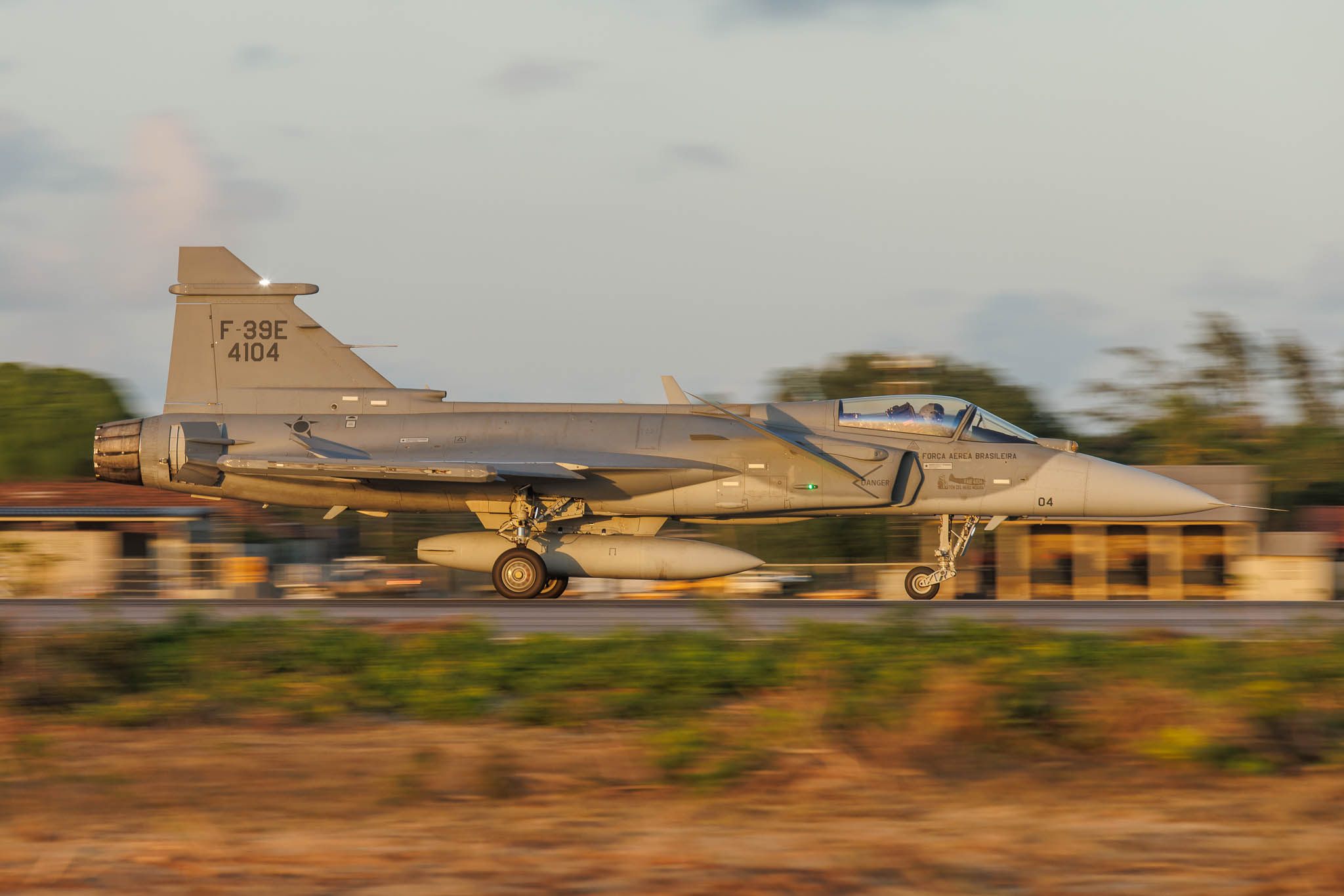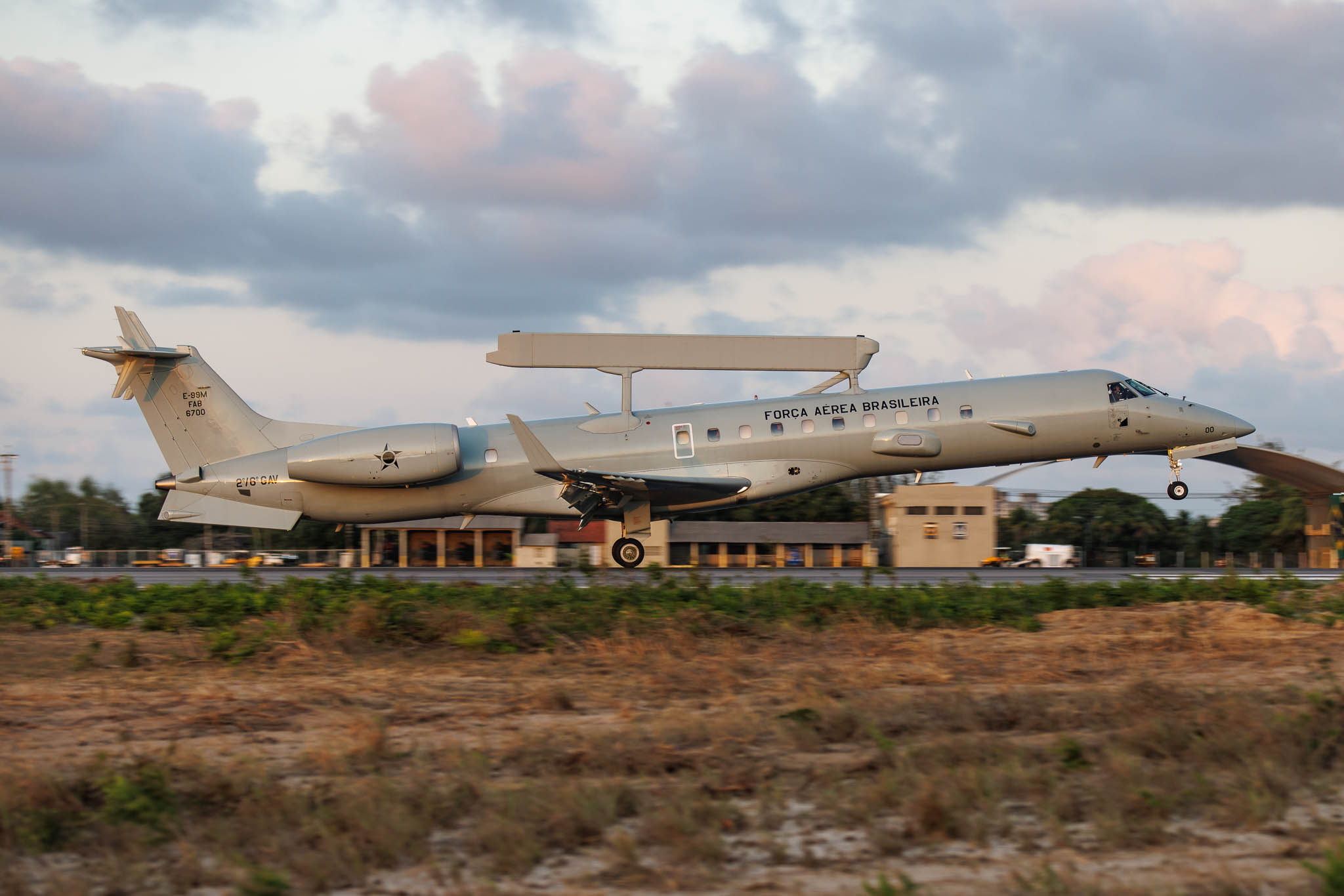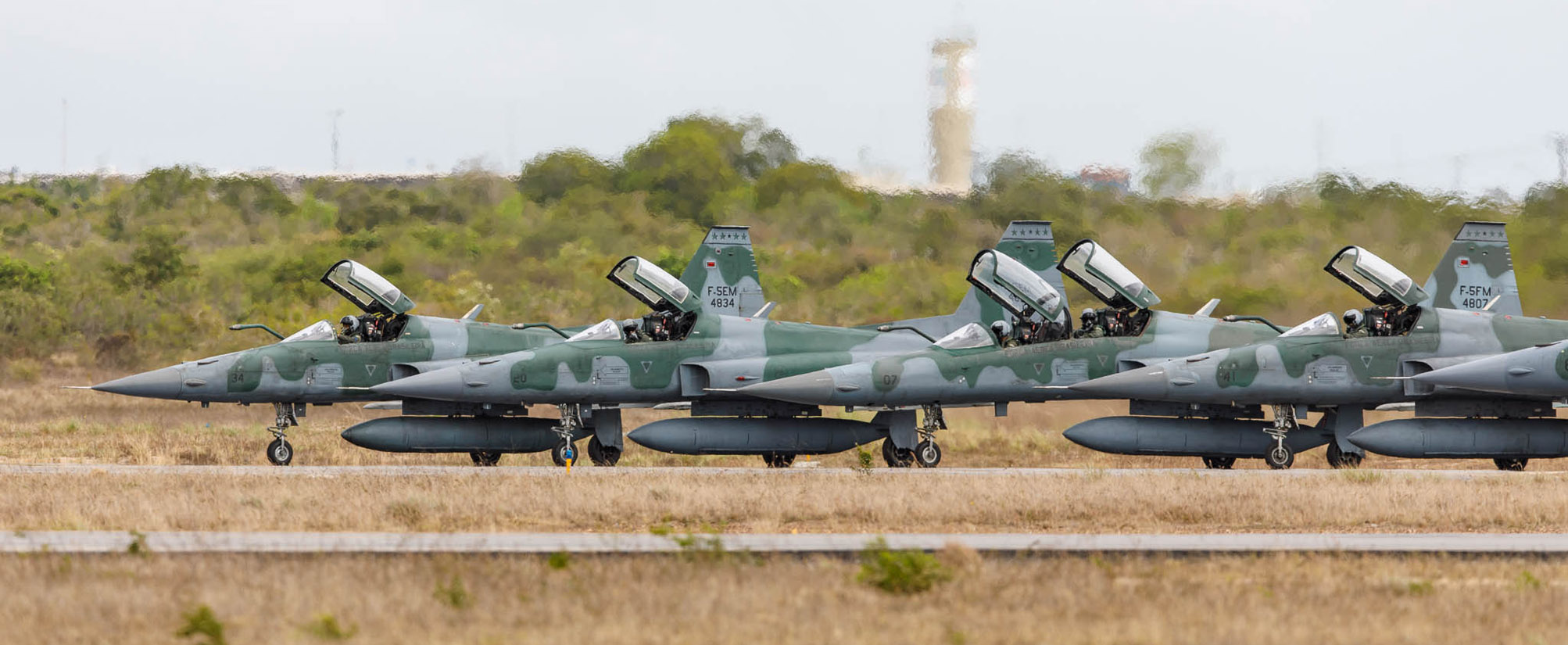Cruzex 2024
Natal Air Base (BANT)
Rio Grande do Norte, Brazil
November 3-7, 2024
|
 |
Saab F-39E Gripen (4104) with 1° GDA (Grupo de Defensa Aérea) 'Jaguar', Força Aérea Brasileira (FAB, Brazilian Air Force), based at Anápolis (Ala 2). In operation since December 2022 the F-39E Gripen was participating in Cruzex for the first time.
F-39 Gripen's activities include Air Opposition Operations, coordinated by the Air Defense Package Leader. Additionally, this fighter is equipped with embedded self-defence systems, including the Radar Warning Receiver (RWR), Infrared Search and Track (IRST), and Missile Approach Warning System (MAWS), essential for detecting and countering threats. The exercise scenarios require quick reaction capabilities, known as 'Threat Reaction' where the F-39 tests its response capacity. The fighter undergoes evaluation in advanced tactical missions, performing both offensive Offensive Counter Air (OCA) and Defensive Counter Air (DCA) functions.
According to Lieutenant Colonel Ramon Lincoln Santos Forneas, Commander of the 1º GDA, CRUZEX pilots in training operate both as enemy and allied forces, with the latter being their primary role.
"In this context, we will conduct Offensive Counter Air (OCA) operations, where the F-39 Gripen will protect friendly forces as they execute actions within enemy territory, as well as Defensive Counter Air (DCA) operations aimed at defending against enemy attacks," explained Lieutenant Colonel Forneas. |
The Força Aérea Brasileira (FAB, Brazilian Air Force) hosted the multinational operational exercise CRUZEX, the Preparation Command (COMPREP) inviting flying squadrons from; Brazil, Argentina, Chile, Colombia, United States, Paraguay, Peru, and Portugal. This was the ninth edition of Cruzeiro do Sul (Southern Cross – CRUZEX) Exercise and the first since 2018. 100 aircraft were involved along with 3,000 military personnel from 16 countries.
Operating from Base Aérea de Natal (BANT), the exercise consists of three phases: the first, called FAM (Familiarisation), includes familiarization flights to help crews adapt to the Area of Operations; the second, FIT (Forces Integration Training), promotes integration among the various participating Air Forces; and the final phase will feature flights in pre-planned scenarios with multiple aircraft, known as Composite Air Operations (COMAO). The aim of CRUZEX 2024 was to update tactics, techniques, and procedures in composite air operations, preparing the Armed Forces for conventional warfare scenarios and complex challenges.
The FAB deployed a diverse fleet of aircraft, including the KC-390 Millennium (aerial refuelling), F-39E Gripen, both aircraft types for the first time, in addition to F-5EM/FM Tiger II, A-1AM-AMX, A-29B Super Tucano, transport and communications aircraft; C-99, C-105/SC-105 Amazonas, reconnaissance aircraft R-99 and E-99, and H-36 Cougar helicopters. The Brazilian Navy provided two AF-1 Skyhawks for the first part of CRUZEX.
Other participating nations provided; F-15C Eagles (United States), F-16 Fighting Falcons (Chile), AT-27 (Paraguay), IA-63 Pampa (Argentina), and KT-1P (Peru). Additional aerial refuelling was provided by Colombia (KC-767/MMTT Jupiter), Chile (KC-135 Stratotanker), Portugal (KC-390) and United States (KC-46 Pegasus).
The familiarisation (FAM) phase, aimed at building situational awareness and adapting to the operational environment in the Natal region.
The Forces Integration Training (FIT) phase introduces missions focused on specific tactics and procedures. Participating nations conduct integrated operations with a limited number of aircraft, simulating situations that require precision in military tactics and combat techniques.
Finally, the COMAOs were designed to simulate the integration of various forces to complete complex tasks within a short period, intensifying interoperability among participants. Their aim was to improve the efficiency and effectiveness of units in a combat environment, demanding precision and agility to meet strategic objectives. Air operations included, advanced air alerts, ground attacks, in-flight refuelling, combat air patrols, escort, sweeps, cargo and personnel airlift.
The E-99M equipped with the ERIEYE airborne radar were tasked with performing In-Flight Control and Alarm (CAV) actions, which are crucial to supporting COMAOs. The E-99M has the capability to detect aircraft over long distances, including those flying at low altitudes, and distinguish between friendly and enemy aircraft. This ability enables strategic airspace surveillance and control of friendly aircraft operating in the scenario.
The R-99 aircraft served as the Airborne Communication Station (PCOM-AR) during CRUZEX, carrying out an essential mission communicating between aircraft flying in the combat area.
|
 |
Embraer KC-390 Millennium with 1°GTT Primeiro Grupo de Transporte de Tropa, Força Aérea Brasileira (FAB, Brazilian Air Force), based at Anápolis (Ala 2). |
Lieutenant Colonel Bruno Américo Pereira, Commander of the 1°GTT emphasised the importance of early preparation. "Zeus Squadron began CRUZEX preparations early, mobilizing equipment and, in this final preparation phase, gathering the involved personnel. During the exercise, the squadron will be trained in in-flight refuelling, aerial resupply, airborne assault, infiltration, and exfiltration. The training also includes leading missions as the Airlift Package Leader and self-defense against threats, using the on-board systems of the KC-390 Millennium aircraft."
 |
Embraer KC-390 Millennium from Quinta Força Aérea 1°/1°GT Primeiro Esquadrão do Primeiro Grupo de Transporte 'Gordo' based at Rio de Janeiro-Galeão/Antônio Carlos Jobim International. |
FAB's multi-mission cargo aircraft has undertaken critical missions, including aerial refuelling (REVO), aerial resupply, airdrop assault—deploying Brazilian Army troops, as well as infiltration and exfiltration of troops. According to Lt Col Pereira, the presence of the KC-390 in this exercise was crucial, as it allows involved forces to maximize their response capability in a controlled yet realistic environment, preparing troops to face real challenges in combined operations. "REVO enables other aircraft to extend their range, a key factor for prolonged operations and for the success of missions in remote and hard-to-access areas. KC-390's aerial refuelling capability demonstrates its efficiency and its indispensable role in extending the reach of operations. The KC-390 Millennium proves to be a 'state-of-the-art' aircraft, showing its capability to meet the demands of a challenging exercise like CRUZEX," said the Squadron Commander.
The KC-390 is equipped with two refuelling pods mounted on its wings, from which hoses extend, with baskets at the edges. The receiving aircraft, typically a fighter jet or another aircraft with a probe system, aligns its probe with the basket on the Millennium's fuel tank. This aerial refueling capability allows combat, transport, or surveillance aircraft to stay operational for longer periods of time, which is vital for long-range missions or areas where landing and takeoff are not feasible. This operational flexibility is crucial in air defense missions, aeromedical evacuation, cargo transport in remote areas, and rapid emergency response. KC-390 can also refuel more than one aircraft during a single flight, depending on operational conditions, enhancing its efficiency and utility in military or humanitarian operations.
|
 |
 |
Left to right: The Fuerza Aérea de Chile (FACh - Chilean Air Force) deployed five Lockheed Martin F-16C/D Block 50 Fighting Falcons from Grupo de Aviación Nº3 based at Iquique/Diego Aracena Base Aérea Los Condores. In support was Boeing KC-135E Stratotanker with Grupo de Aviación Nº10, based at Santiago/Comodoro Arturo Merino Benitez International (Base Aérea Pudahuel).
Major General Nelson Pardo Ocaranza, Commander of the Chilean Air Force Group participating in CRUZEX 2024, highlighted the exercise's significance and the challenges it presents for his Force. "Given the scale of the structure and the resources involved in CRUZEX, this exercise enables the Chilean Air Force to strengthen interoperability with the other participating air forces. It enhances our operational readiness while enriching the exchange of knowledge and experiences in utilizing air power in a multi-domain environment, all within NATO planning methodologies. Undoubtedly, CRUZEX is an opportunity that reinforces the bonds among participating forces, validating the importance of creating operational spaces for a common purpose." |
 |
| Boeing KC-135E Stratotanker (982) with Grupo de Aviación Nº10, Fuerza Aérea de Chile (Chilean Air Force). It is based at Santiago/Comodoro Arturo Merino Benitez International (Base Aérea Pudahuel). |
Left to right: 14 Força Aérea Brasileira (FAB, Brazilian Air Force) Northrop F-5EM/FM Tiger II with 1°/14° GAv (Primeiro Esquadrão do Quinto Grupo de Aviação) 'Pampa', deployed from Canoas (Ala 3) for CRUZEX 2024.
The F-5 fighter was tasked with air defence missions and stands out for its ability to manage tactical formations, also serving as Air Defence Package Leader. Its role was to protect airspace, coordinating defence and escort actions against threats and ensuring the safety of aircraft and strategic assets. The F-5 is also evaluated in in-flight refuelling operations, crucial for extending mission range. |
 |
Left to right: A number of Força Aérea Brasileira (FAB, Brazilian Air Force) Embraer A-29B Super Tucano with 2°/5° GAv (Primeiro Esquadrão do Quinto Grupo de Aviação) 'Joker', based at Natal-Augusto Severo (Ala 10) were flown during CRUZEX 2024. A total of 99 Embraer EMB 314 Super Tucano were ordered in 2001. 66 of these aircraft are two-seater A-designated A-29B. The remaining 33 aircraft received were the single-seat A-29 ALX version. The final delivery was made in 2012.
The A-29 Super Tucano conducted integrated attacks, offering versatile performance by engaging ground targets with conventional weaponry. Equipped to respond to both air and ground threats, the A-29 has self-defence systems that enhance its effectiveness in mixed-threat operations. |
 |
The United States deployed six McDonnell Douglas F-15C Eagles from the 159th Fighter Wing, 122nd Fighter Squadron 'Bayou Militia', Louisiana Air National Guard (LA ANG). Based at the Naval Air Station Joint Reserve Base in New Orleans.
For CRUZEX 2024, the United States brought the F-15 Eagle to Brazil for the first time. Major Michael Scott, one of the pilots, highlighted the importance of the exercise, emphasizing the mutual learning air forces gain from operating together. He acknowedged that the opportunity to train in Brazil presented new challenges and training opportunities for pilots and military personnel. "The F-15's performance in combat missions is one of the aircraft's primary specialties. We are here to enhance our cooperation capabilities and strengthen bonds with our allies," he said, underscoring the importance of simulating realistic air combat scenarios to bolster the readiness of all participants.
|
 |
Left to right: Embraer E-99M (EMB 145 AEW&C) (6700 and 6703) with 2°/6°GAv (Primeiro Esquadrão do Quinto Grupo de Aviação), Força Aérea Brasileira (FAB, Brazilian Air Force) based at Anápolis. They are tasked with Airborne Early Warning and Control and has a distinctive roof mounted Erieye radar beam.
Embraer R-99 (6750) with 2°/6°GAv, Força Aérea Brasileira (FAB, Brazilian Air Force) it is based at Anápolis.
Embraer C-99A (EMB-145ER) (2522) with 1°/2°GT (1° Esquadrão do 2° Grupo de Transporte), Força Aérea Brasileira (FAB, Brazilian Air Force), it is based at Rio de Janeiro-Galeão/Antônio Carlos Jobim International (Ala 11).
The Commander of the 2º/6º GAV, Guardian Squadron, Lieutenant Colonel David Dantas da Silva, explained that E-99 and R-99 aircraft provide advanced monitoring and reconnaissance, offering real-time data for coordination and operational security. "Our role in CRUZEX is to ensure that all aircraft in the exercise area have clear communication and are visible on radar. We work with ground teams to provide proper training to all participants and ensure that all safety parameters are maintained," he reported.
According to the Chief of the Third Military Operations Center (COPM3), Captain Marcio Luiz Melo Bonin, Air Traffic Control Specialist, these missions enable efficient coordination and communication among all those involved in COMAO, enhancing the combat and incursion capabilities of friendly aircraft. "The operations take place in highly diverse scenarios, with aircraft operating at extremely high altitudes and others at very low levels, requiring strict coordination and control to ensure mission effectiveness. In this regard, the E-99 aircraft serves as a platform for In-Flight Control and Alarm missions, while the R-99 functions as an Airborne Communication Station, among other operational roles." |
 |










